Review of the best according to the editorial board. On the selection criteria. This material is subjective, does not constitute advertising and does not serve as a purchase guide. Before buying, you need to consult with a specialist.
The sights are different. Usually these are objects in which historical and cultural value is initially invested – monuments, museums and galleries; sometimes they acquire this value as a result of historical events or due to their antiquity – places of battles, ancient castles, palaces, houses. And sometimes something unusual just arises, attracting the attention of people, and thanks to this it becomes a tourist attraction. This article will discuss the original and unusual street attractions that can be seen while traveling in Europe.
- Overview of unusual roadside attractions in Europe
- Headington Shark (Oxford, UK)
- Kelpie (Grangemouth, Scotland)
- Boar Voynich (Sols-Montclin, France)
- Osborne Bulls (Spain)
- House-stone (Fafe, Portugal)
- Fork (Vevey, Switzerland)
- Snail house (Sofia, Bulgaria)
- Hill of Crosses (Siauliai, Lithuania)
- Tuborgflasken (Hellerup, Denmark)
- Royal Heads (Oakley Green, UK)
Overview of unusual roadside attractions in Europe
| Nomination | a place | name | rating |
| Rating of unusual roadside attractions in Europe | 1 | Headington Shark (Oxford, UK) | 5.0 |
| 2 | Kelpie (Grangemouth, Scotland) | 4.9 | |
| 3 | Boar Voynich (Sols-Montclin, France) | 4.8 | |
| 4 | Osborne Bulls (Spain) | 4.7 | |
| 5 | House-stone (Fafe, Portugal) | 4.6 | |
| 6 | Fork (Vevey, Switzerland) | 4.5 | |
| 7 | Snail house (Sofia, Bulgaria) | 4.4 | |
| 8 | Hill of Crosses (Siauliai, Lithuania) | 4.3 | |
| 9 | Tuborgflasken (Hellerup, Denmark) | 4.2 | |
| 10 | Royal Heads (Oakley Green, UK) | 4.1 |
Headington Shark (Oxford, UK)
Rating: 5.0
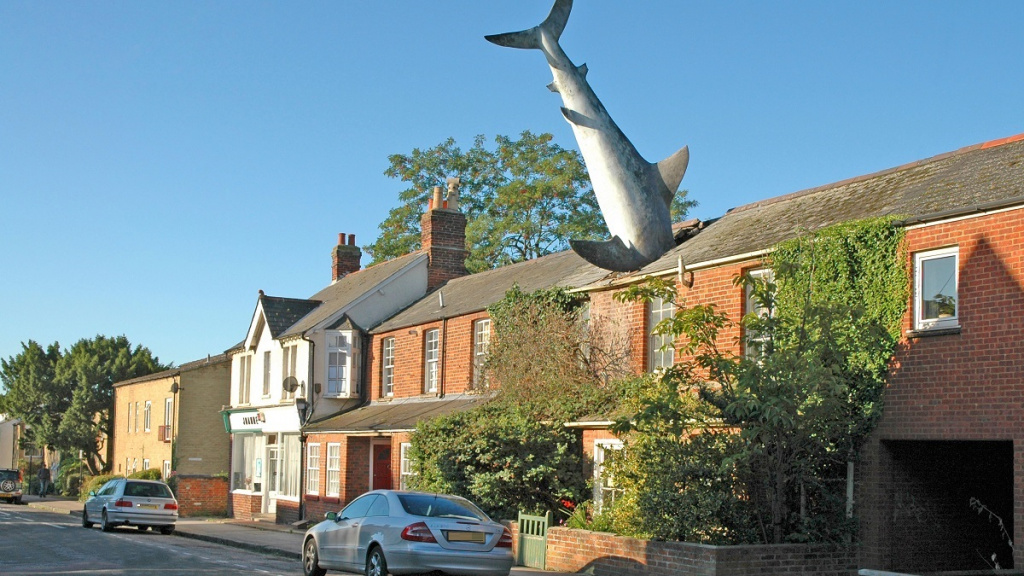
In Oxford, Headington, on the roof of the most ordinary building – house number 2 on New High Street, is a fiberglass shark piercing the roof with its head. The house owner, local radio host Bill Heine, and sculptor John Buckley installed it on the night of August 9, 1986, on the 41st anniversary of the atomic bomb dropped on Nagasaki. Bill Heine claimed to have installed a shark in protest against the “nuclear age”, the Chernobyl disaster and the bombing of Hiroshima and Nagasaki. She is a call for nuclear disarmament.
Oxford City Council, however, did not approve of his initiative. The shark was considered unsafe if it fell from the building. When, after checking, it turned out that the shark was not dangerous, they found another reason to remove it – the lack of permission for planning work. In addition, the suspicion arose that the shark was just a disguise for the unauthorized installation of a television antenna, the height of which was higher than the permitted one. However, after the Minister of the Environment ruled that the shark can be left as it does not harm the city's aesthetics, the claims were dropped. In 2007 the shark was repaired.
The shark, reminiscent to some of the bomb that pierces the roof, made Headington famous, which did not interest tourists until 1986, when this attraction appeared. The inhabitants themselves have not noticed it for a long time, but for the whole world it serves as an example of bold pacifist art.
Kelpie (Grangemouth, Scotland)
Rating: 4.9
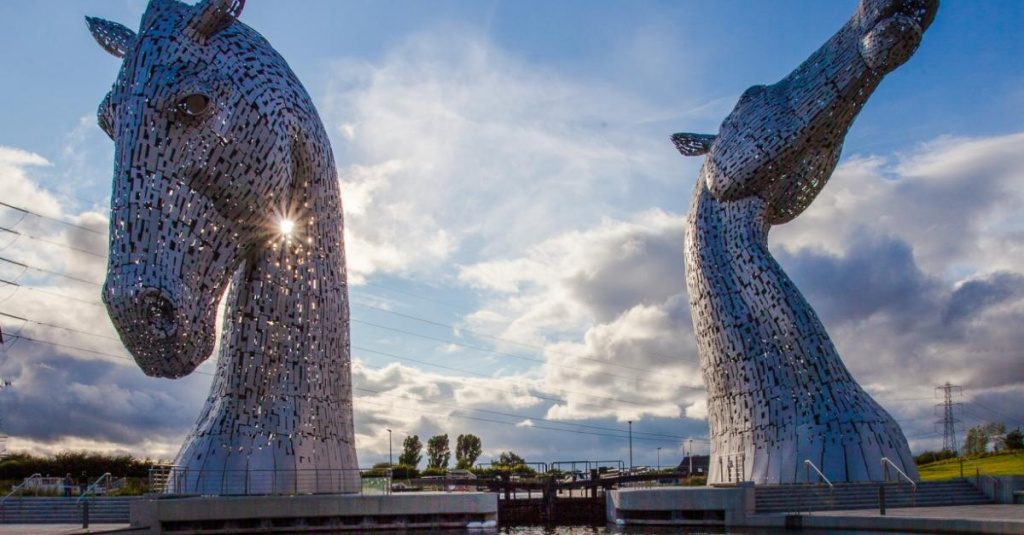
Kelpie is a spirit in Scottish mythology. He appears in the form of a horse coming from a river or lake, allows the traveler to saddle himself and goes under the water with him. In the Scottish town of Grangemouth, there are sculptures symbolizing the Kelpies – two giant twin horse heads that “guard” the Fort Clyde Canal. They were installed by architect Andy Scott in October 2013.
The height of the sculptures is 35 meters. In addition to the aesthetic, the sight has a practical purpose. The heads move slowly back and forth, pushing water into the lock at the east end of the canal and letting ships through. According to the creator's idea, these sculptures should be the first thing a tourist sees when sailing to the UK. In addition, Andy Scott assumed that it was these horse heads that would invite tourists to Scotland.
Boar Voynich (Sols-Montclin, France)
Rating: 4.8

The world's largest boar sculpture is located in France, near the Belgian border. This landmark appeared here not by chance – among the Normans, the boar serves as a symbol of military power, strength and courage, the ability to protect their land and their families.
The height of the giant boar is 8.5 meters at the withers, the length is 11 meters. The boar was made by sculptor Eric Sleziak. The sculptor completed the work by 2008, it took 11 years to create the landmark. The boar is made of steel sheets and weighs 50 tons. There is a hatch through which you can go inside the sculpture – it is located at the bottom of the boar's belly.
The sculpture was collected in a nearby town and then transported by truck to its place on the hill. Crowds of local people accompanied him. The boar was placed on a revolving platform, where it still stands. The French A34 motorway is close by, and drivers who drive along it often take photos near this attraction.
Osborne Bulls (Spain)
Rating: 4.7
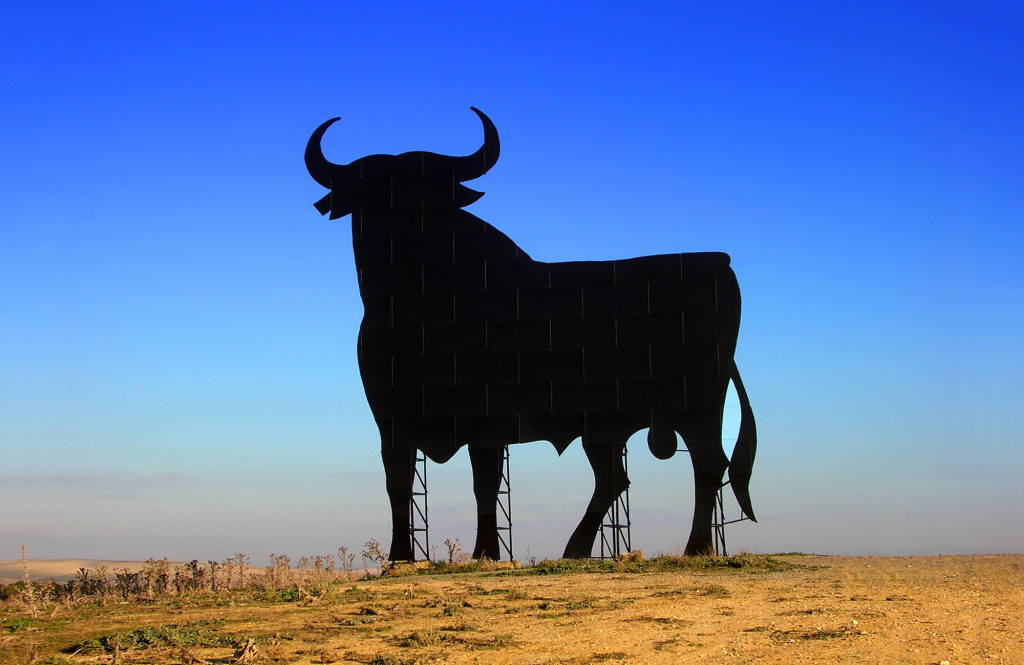
Osborne's bull is the unofficial national symbol of Spain. It is a massive, black beast made of metal – the emblem of the Veterano sherry brandy. His figures can be found throughout the countryside in Spain – there are 91 Osborne bulls in the country.
Bull-shaped billboards have been installed since 1958. At first, the bulls were 4 meters high, but began to grow in 1962 when a law was passed in Spain prohibiting the installation of billboards closer than 125 meters from roads. So that at such a distance the silhouettes of the bulls were still visible, their height was increased to 14 meters. In 1988, when advertising along the roads was completely banned, the Veterano inscription on the bulls was painted over, and since then they have been perceived as a landmark of the country, and not as an advertisement.
Now bulls are a kind of symbol of Spain, a feature of the Spanish landscapes. By the way, it is also an unofficial symbol of local sports. Spanish fans often use the Osborne bull on the country's flag.
House-stone (Fafe, Portugal)
Rating: 4.6
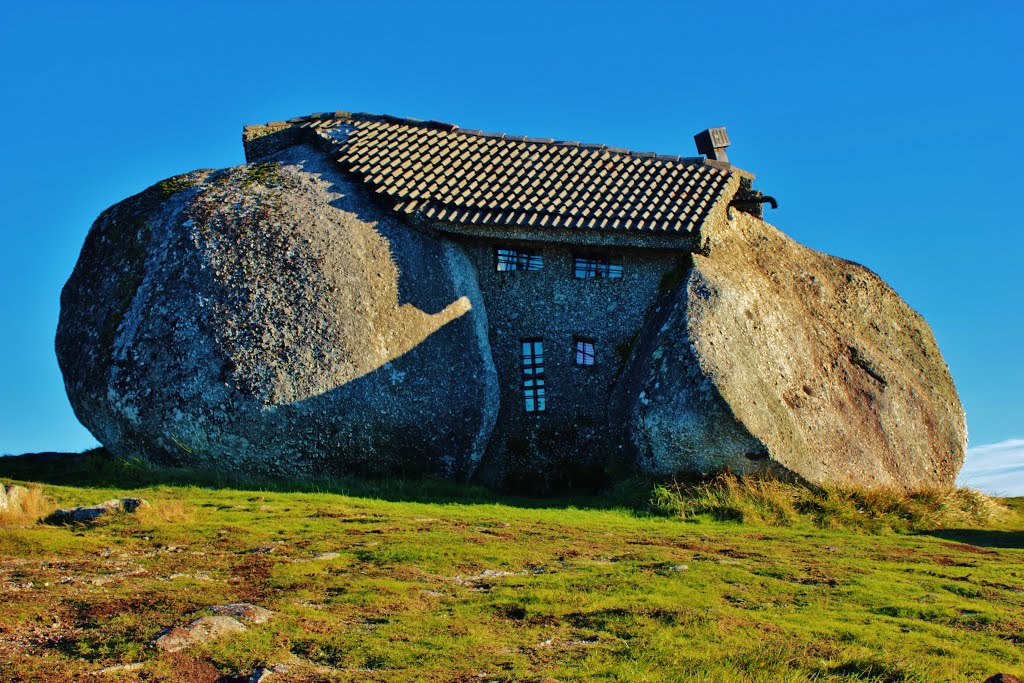
In Portugal, 10 kilometers northeast of the city of Fafe and 60 kilometers southwest of Porto, there is an unusual house, the foundation and walls of which are four huge stones. It is located on a 793 meter high mountain. The house was built in 1974.
The house is two-storey, the height inside is 5.5 meters. Inside the house there is a typical rustic setting: fireplace, table, bedrooms. The windows and doors in the house are bulletproof. Despite the fact that there are windmills nearby, electricity is not supplied to the house – candles are used for lighting. Not far from the house are other stone structures – a summer kitchen and a now empty pool.
The owners of the house used it as a place to relax. For this, the house was placed on a hill, far from the city. However, the house soon attracted the attention of tourists, and the owners had to first make a fence and then leave the house. After that, the house housed a museum, where photographs of the surroundings and various artifacts were collected. Now, most likely, the house is inaccessible for visiting, and it can only be seen from a distance of about 100 meters.
Fork (Vevey, Switzerland)
Rating: 4.5

In the Swiss city of Vevey, there is a landmark that immediately catches your eye – a huge, 8 meters high, fork stuck into Lake Geneva. This cutlery appeared here in 1995 – it was installed by the artists Georges Favre and Jean-Pierre Zaug when the Alimentarium Food Museum celebrated its tenth anniversary.
This attraction immediately attracted the attention of tourists and journalists. Despite this, in 1996, the Alimentarium was not allowed to leave the plug in its place. It was seen only as a museum advertising medium that could encourage other giant advertising objects to be installed in the lake. Only in 2008, at the request of local residents, the landmark was returned. In 2014, the fork entered the Guinness Book of Records as the highest in the world.
The attraction is of great interest to tourists, encouraging them to take original photos. In 2014, the Alimentarium even launched a contest for the best photo with a giant fork on Instagram.
Snail house (Sofia, Bulgaria)
Rating: 4.4
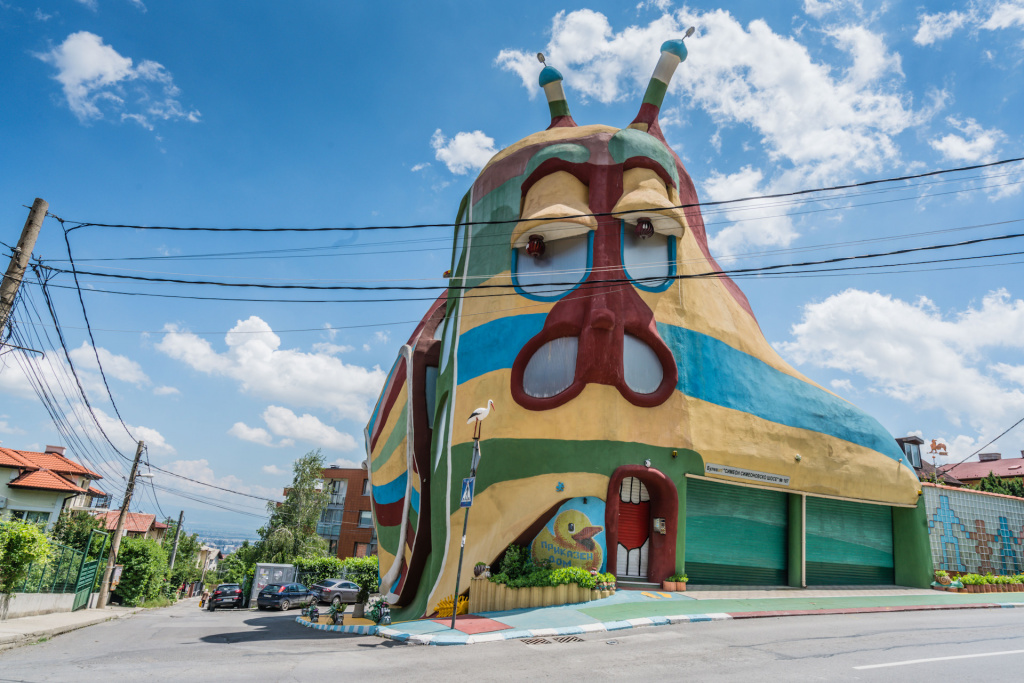
The Simeonovo quarter, located on the outskirts of Sofia, is not very popular with tourists. However, it is there that a very strange attraction is located – a huge rainbow snail. The snail is colored with stripes of red, orange, green, blue and brown. The building has no right angles or walls. House height – 5 floors.
The architect of the building, Simeon Simeonov, built it as far as possible from the traditional way. All parts of the building – for example, two tentacles on the “head” and curved windows – fit into the big picture. For example, the front door looks like the “mouth” of a snail – the snail “eats” everyone entering. The chimney is replaced by a large yellow bee on the back of the snail. In addition to the fact that the bee releases smoke from the house, its horns are both lanterns and lightning rods. Even the eyes have their own purpose – through them the building is ventilated. The batteries are disguised as toads, ladybugs and pumpkins.
Also, during the construction of this landmark, the idea of preserving the planet was invested in it: the snail house was built entirely of light and environmentally friendly building material – polymer concrete.
The house was fully built in 2009 and took 10 years to build. The owner of the house is unknown, as well as its purpose is not clear. They said that they want to open either a kindergarten, or a school, or a certain businessman plans to live in it. In the meantime, the main function of the house is to attract tourists; it is becoming one of the most popular attractions in Sofia.
Hill of Crosses (Siauliai, Lithuania)
Rating: 4.3

12 kilometers north of the Lithuanian city of Siauliai, on the road from Kaliningrad to Riga, there is an unusual hill. It is unusual in that there are tens of thousands of crosses and crucifixes of various sizes and types on it – from multi-meter wooden ones to small iron crosses. The hill is not a graveyard. The reason why more and more crosses appear on it is the popular belief that the one who installs a cross here will be pursued by good luck.
Crosses began to appear on the hill since the 19th century or earlier – it is not known for sure. There are several versions of why this attraction arose. According to one of them, before the adoption of Catholicism by Lithuania, which happened in the XIV century, there was a pagan temple here. After the remnants of paganism, coupled with Catholic postulates, they created the tradition of placing crosses on this hill. According to the other, the crosses are the memory of the Lithuanians who died in 1831 during the suppression of the Lithuanian uprising by the Russian Empire.
The Soviet government tried to destroy this landmark four times, but to no avail. In 1993, Pope John Paul II visited Lithuania and installed a crucifix on the mountain. This attracted the attention of Catholic tourists to the site. However, Christians of other confessions also visit this place. A Jewish symbol, the Star of David, was recently installed.
Tuborgflasken (Hellerup, Denmark)
Rating: 4.2

Tuborgflasken is a 26-meter Pilsner bottle sculpture from the Tuborg brewery. This landmark was installed back in 1888. Then the Tuborg company took part in the Scandinavian exhibition, and the sculpture was a demonstration of the main direction of the enterprise. Initially, the bottle was in Copenhagen, where the Copenhagen City Hall is now located, and later it was transported to Hellerup.
Tuborg is the first Danish company to promote bottled beer as an alternative to beer kegs. The sculpture was created by architect Viggo Klein and artist Karl Lund. The bottle was equipped with the first mechanical lift in Denmark, which took visitors to the observation deck at the top of the bottle. In the dark, electric lighting was on, making the top of the bottle visible in the dark.
The 26-meter bottle stands next to the headquarters of Tuborg. The observation deck no longer works, but the sculpture itself is still popular with tourists who take pictures next to it.
Royal Heads (Oakley Green, UK)
Rating: 4.1
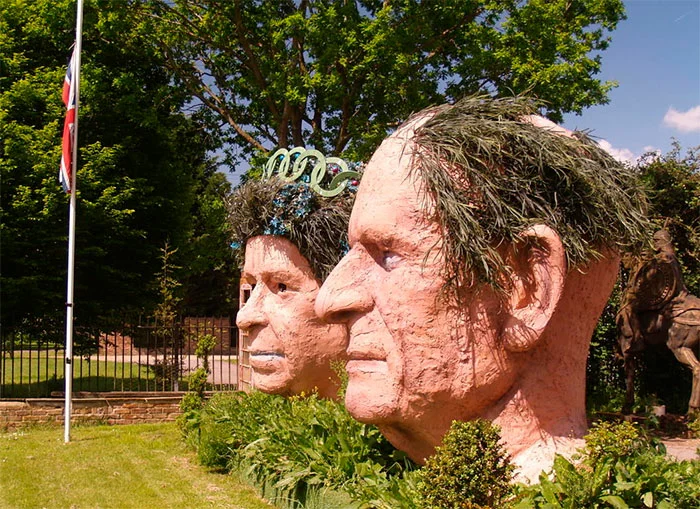
The huge terracotta heads of Queen Elizabeth and Prince Philip can be seen when driving to Windsor on the B3024. The heads are on the left side of the road. The heads are 3 meters high and are made of a mixture of plaster and terracotta. The hair of the heads is made of artificial grasses and flowers, the eyes are made of tennis balls.
Local resident Ben Bennett, owner of a waste disposal company, found heads in Chelsea after celebrating the anniversary. They were thrown into a landfill. Bennett took them to his garden in Oakley Green. Windsor Castle is 5 miles away and is where royal couples often hang out.
The owner of the house welcomes guests and is ready to show them his garden. In addition to this attraction, there are also various sculptures in the garden, such as a statue of a Mongol warrior on horseback, a telephone booth, and an old small van. He also has a mobile blood test booth.
Attention! This rating is subjective and does not constitute an advertisement and does not serve as a purchase guide. Before buying, you need to consult with a specialist.








